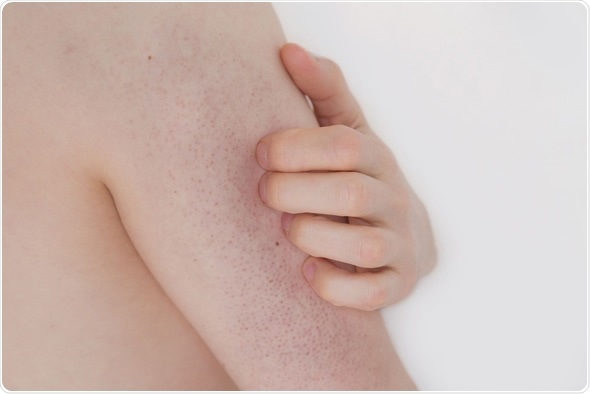Keratosis pilaris is a very common skin condition in which keratin forms hard plugs in the hair follicles.

Image Copyright: lavizzara / Shutterstock
It is an inherited disorder running in families with a 1 in 2 chance of each child inheriting it from an affected parent. Keratosis pilaris is not infectious.
Keratin is a natural protein present in the outer portion of the skin. There are many different types of keratin such as A-keratin and B-keratin. These keratins help build different types of skin appendages such as hair and nails. In some people, the body produces abnormally higher amounts of keratin, which forms plugs that clog the pores in the skin. In keratosis pilaris, the hair follicles are trapped inside the keratin plugs and tiny, hard bumps start appearing around the clogged pores leading to a change in the texture of the skin from smooth to rough.
Keratosis pilaris is generally harmless and is characterized by dry and rough patches on the skin and also tiny bumps in the affected parts. Rough patches and bumps from this condition usually affect the skin of the cheeks, upper arms, thighs, or buttocks. The bumps are usually not itchy or painful.
There is no cure for keratosis pilaris and it is often regarded as a variant of normal skin. There are treatment options available that aim at moisturizing and removing dead cells from the affected skin. Prescription as well as over the counter moisturizing creams can aid in improving the symptoms.
Symptoms of Keratosis Pilaris
Keratosis pilaris can affect people of any age, though it is more common in young children. The condition usually gets better on its own around the age of 30. Signs and symptoms of keratosis pilaris include the following:
- Small, grainy bumps that look like goose bumps, usually on sides of cheeks, upper arms, buttocks, or thighs. Such bumps on the face are usually mistaken for acne.
- Rough and dry skin in the areas in which the bumps are present
- Bumps give the texture of sandpaper to the skin, which looks like chicken skin
Scaly spots may also appear causing red or brown skin coloration, called keratosis pilaris rubra and hyper-pigmented keratosis pilaris, respectively. None of these spots or bumps are sore or itchy.
Symptoms usually worsen with seasonal changes, especially in winter as the decrease in humidity makes the skin drier. Keratosis pilaris generally affects the outer portion of upper arms, and rarely the forearms and upper back. The distribution of the bumps is generally symmetrical.
Keratosis Pilaris Atrophicans
Keratosis pilaris atrophicans is a rare variant of keratosis pilaris, which is characterized by hair loss and follicular depressions that look like scars. This condition can affect the face (called keratosis pilaris atrophicans faciei), neck (called erythromelanosis follicularis faciei et colli), eyebrows (called Ulerythema ophryogenes), scalp (called keratosis follicularis spinulosa decalvans), and cheeks (called atrophoderma vermiculata / folliculitis ulerythematosa reticulata or pitted scarring of cheeks).
Diagnosis of Keratosis Pilaris
Diagnosis of keratosis pilaris is usually simple. A dermatologist can diagnose this condition by just examining the bumps and spots in the affected areas of the skin. Tests or exams are usually not needed for diagnosis of keratosis pilaris. In rare cases, biopsy is needed and reveals hypergranulosis, epidermal hyperkeratosis, superficial perivascular lymphocytic inflammation, and plugged hair follicles.
Keratosis pilaris is usually harmless and does not require treatment. It normally clears by itself with increase in age. However, if you are concerned about the appearance of the affected skin or if the symptoms are bothering you despite application of over the counter moisturizing creams and lotions, consult a dermatologist (skin specialist).
References
Further Reading